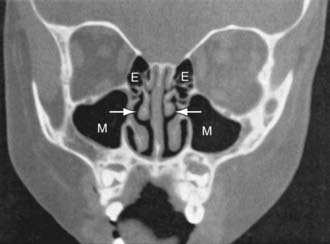Chapter 372 Sinusitis
Sinusitis is a common illness of childhood and adolescence with significant acute and chronic morbidity as well as the potential for serious complications. There are 2 types of acute sinusitis: viral and bacterial. The common cold produces a viral, self-limited rhinosinusitis (Chapter 371). Approximately 0.5-2% of viral upper respiratory tract infections in children and adolescents are complicated by acute bacterial sinusitis. Some children with underlying predisposing conditions have chronic sinus disease that does not appear to be infectious. The means for appropriate diagnosis and optimal treatment of sinusitis remain controversial.
Both the ethmoidal and maxillary sinuses are present at birth, but only the ethmoidal sinuses are pneumatized (Fig. 372-1). The maxillary sinuses are not pneumatized until 4 yr of age. The sphenoidal sinuses are present by 5 yr of age, whereas the frontal sinuses begin development at age 7-8 yr and are not completely developed until adolescence. The ostia draining the sinuses are narrow (1-3 mm) and drain into the ostiomeatal complex in the middle meatus. The paranasal sinuses are normally sterile, maintained by the mucociliary clearance system.

Figure 372-1 Coronal CT scan of normal 3 yr old child. Arrows point to middle meatus. E, ethmoid sinuses; M, maxillary sinuses.
(From Isaacson G: Sinusitis in childhood, Pediatr Clin North Am 43:1297–1317, 1996.)
Etiology
The bacterial pathogens causing acute bacterial sinusitis in children and adolescents include Streptococcus pneumoniae (∼30%; Chapter 176), nontypable Haemophilus influenzae (∼20%; Chapter 186), and Moraxella catarrhalis (∼20%; Chapter 188). Approximately 50% of H. influenzae and 100% of M. catarrhalis are β-lactamase positive. About 25% of S. pneumoniae may be penicillin resistant. Staphylococcus aureus, other streptococci, and anaerobes are uncommon causes of acute bacterial sinusitis in children. Although Staphylococcus aureus is an uncommon pathogen for acute sinusitis in children, the increasing prevalence of methicillin-resistant Staphylococcus aureus (MRSA) is a significant concern. H. influenzae, α- and β-hemolytic streptococci, M. catarrhalis, S. pneumoniae, and coagulase-negative staphylococci are commonly recovered from children with chronic sinus disease.
Epidemiology
Acute bacterial sinusitis can occur at any age. Predisposing conditions include viral upper respiratory tract infections (associated with out-of-home daycare or a school-aged sibling), allergic rhinitis, and cigarette smoke exposure. Children with immune deficiencies particularly of antibody production (immunoglobulin G [IgG], IgG subclasses, IgA) (Chapter 118), cystic fibrosis (Chapter 395), ciliary dysfunction (Chapter 396), abnormalities of phagocyte function, gastroesophageal reflux, anatomic defects (cleft palate), nasal polyps, cocaine abuse, and nasal foreign bodies (including nasogastric tubes) can develop chronic sinus disease. Immunosuppression for bone marrow transplantation or malignancy with profound neutropenia and lymphopenia predisposes to severe fungal (aspergillus, mucor) sinusitis, often with intracranial extension. Patients with nasotracheal intubation or nasogastric tubes may have obstruction of the sinus ostia and develop sinusitis with the multiple-drug resistant organisms of the intensive care unit (ICU).



